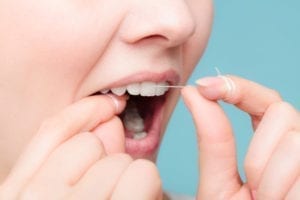 Even though you may already be brushing twice daily as recommended by dentists such as Dr. Brad Gorsky, you still might not be doing enough to ward off tooth decay and gum disease. Although brushing your teeth is a vital part of your oral hygiene regimen, flossing is equally important. Brushing can only remove the easy-to-reach food particles, bacteria and plaque in your mouth.
Even though you may already be brushing twice daily as recommended by dentists such as Dr. Brad Gorsky, you still might not be doing enough to ward off tooth decay and gum disease. Although brushing your teeth is a vital part of your oral hygiene regimen, flossing is equally important. Brushing can only remove the easy-to-reach food particles, bacteria and plaque in your mouth.
Plaque is a sticky but clear and colorless substance created when leftover food particles combine with saliva and attach to your teeth. In plaque, the normally harmless bacteria finds nourishment and begins devouring the plaque, eventually eating right into your tooth enamel which eventually leads to cavities – holes in your tooth enamel.
Why Is Flossing So Important?
This where flossing can make a critical difference in maintaining your oral health. Flossing removes the plaque that your toothbrush can’t easily reach in tight spots like in between your teeth. However, it is very important that you are flossing properly. It has been said time and again that “an ounce of prevention is worth a pound of cure” and flossing is that ounce of prevention where tooth decay is concerned. Regular flossing can help you to avoid painful, time-consuming and potentially expensive dental procedures that may become necessary when plaque is allowed to settle in around your teeth.
How to Floss Correctly
- Wrap around your middle fingers a length of floss approximately eighteen inches long. Use your thumbs and forefingers to move the floss. You should wind more around one finger than the other so you can wind the already used floss toward the finger with less floss wrapped around it and use a fresh length.
- Push the floss between two teeth and use a gentle back and forth motion all the way from the top of the teeth down to their base where they erupt from your gums.
- Wrap the floss around the side of one tooth in a “U” shape then gently slide up and down your tooth. Repeat this several times, making sure to go slightly underneath the gum-line, then repeat on the other side of the tooth. Do this for each tooth.
- Don’t worry too much if you see that your gums are bleeding as you floss. A little bleeding is perfectly normal if you haven’t been flossing regularly. This bleeding is caused by inflammation of your gums reacting to the bacteria that was dwelling there. If you floss daily as recommended by your dentist, you should see an improvement in the health of gums in the form of reduced bleeding in one to two weeks.
Floss Picks Are Less Effective Than You Think
Some patients prefer to use floss picks. These “Y” shaped pieces of plastic with floss strung between the “arms” of the “Y” are widely available at most stores. However, dentists prefer using a length of “free” floss and your hands. Floss picks don’t allow you to properly floss as you can’t wrap them around a tooth in the “U” shape recommended. However, it’s still better than not flossing at all.
Schedule An Appointment With Your Dentist
Common wisdom is that flossing after brushing your teeth is optimal as there will already be less plaque and food particles to get stuck on the floss. If you’re in the Larchmont, NY area and have any additional questions about brushing, flossing or your oral health, schedule an appointment online with Dr. Brad Gorsky today.
